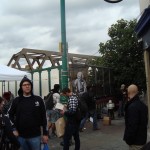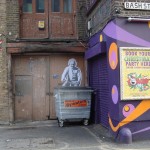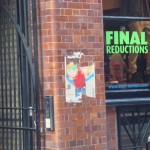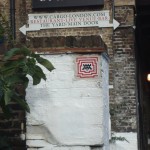Entries from September 2010
September 20th, 2010 · No Comments
London’s public parks are impressive, in their size, beauty, and sheer number. Most people go to these parks to play sports, have picnics, hang out with their mates (both kinds), sit and read under a tree, etc., but my favorite park activity is people watching; and nowhere in London is the people watching better than in Hyde Park’s Speaker’s Corner. Speaker’s Corner is like an internet chat forum come to life, attracting people from every imaginable social background and point of view. Immaculately dressed women toting around their four figure handbags walk by elderly Sikh men in skull caps with long, gray beards. Middle school aged children in football jerseys weave between bikers and joggers. Indian grandmas in wheelchairs are pushed by their grandkids past punk teenagers in six inch platform boots. London’s parks truly attract all kinds, and Speaker’s Corner is the ideal place to find a varied audience if you have something to say, simply set up your little stool, hop on, and begin your diatribe against the government, the media, the cursed masses, who or whatever. If you have anything even remotely interesting to say, a crowd will soon form around you. Wearing a funny costume doesn’t hurt either, the crazier the better.

Just a guy feeding the pigeons. (personal photo)
I’ve simply strolled through most of the parks here, stopping every now and then to admire a flower or dodge a pile of dog poop, but Hyde Park caught my attention and kept it. Right across from the tail end of the Oxford St. madness you will find the Marble Arch, and beyond it a massive expanse of green space. Speaker’s Corner is lodged conveniently in the middle. The first character I encountered was a militant African man speaking out against the war in Iraq. He looked to be about 25 or so, and around him stood a rather sizable crowd. There was also a group of four physically fit 20 somethings advertising a personal training service and attracting quite a crowd with their boxing gimmick. One of the men held up a pad on each hand and challenged people in the crowd to get in 200 punches in one minute. A group of south asian men egged each other on in friendly competition as the crowd laughed and cheered. I was asked to participate, but declined the request. After I had had my fill of watching overweight middle-aged men try and fail to show off athletic prowess, I moved over to listen to a capital C Crazy preacher and the bemused, laughing, and heckling crowd around him.
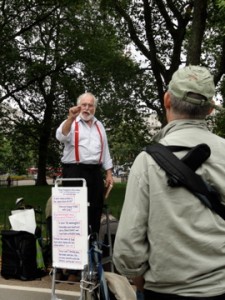
Belligerent preacher pointing at me and asking me something silly like if I knew where I was going when I died. (personal photo)
My favorite speaker was a grizzled old man sartorially channeling the Gorton’s Fisherman. He had a much smaller crowd around him, an interesting mix of homeless people and business men in suits and ties, and me. He wasn’t so much Speaking as having an intimate conversation with his little crowd, discussing poetry and painting, interspersed with personal anecdotes of questionable validity.
Past all of this, Hyde Park is like all the rest, and if you walk in far enough you will undoubtedly be able to stake out your own patch of serenity. Muslin women in full burkas sit and read, couples sit shoulder to shoulder on blankets, its all really a very nice scene. I guess the behavior in the park could be described as English, in that, aside from the liminal space of Speaker’s Corner, people seem to keep themselves, on the whole, its all very orderly.
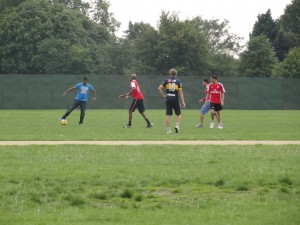
Mates playing a bit of footie. (personal photo)
Tags: 2010 Rachel · Uncategorized
September 20th, 2010 · No Comments
We were asked by our professor to investigate the culture and society that revolves within and around pubs in London. I honestly think he didn’t even have to require us to do it; we did it instinctively. But nevertheless I did what I was asked to do grudgingly, just kidding, I definitely did it willingly. And what I found in my short experience with pubs was that to the British or Londoners in general the pub is the equivalent of the American coffee shop with just a little more pizzazz.
Since our first day in London we have been to a variety of Pubs ranging from overtly tourist pubs to a bit more native pubs. In all the pubs that I visited there is a sense of privacy. Some people who have just gotten off of work go to pubs with co-workers discussing the day’s events over a pint. Others go to pubs alone seeking a sense of solitude to relieve some of the stress. Yet, others attend a pub to see the playing field pick up on someone and maybe have a good night. That is why drinking in the United Kingdom has a largely different connotation to that of the United States. I believe it has more of a positive air than back home. Yes like any other place there are alcoholics here but the majority that I have seen are able to compose themselves and carry on with life.

I definitely had to learn a couple of things when it came to ordering drinks and food at pubs. I first had to learn that customer service in the UK is virtually non-existent. Second there are no waiters what so ever, you go to the bar and order for yourself. Third and this is the most important part, you have to KNOW WHAT YOU WANT BEFORE YOU REACH THE BAR. If you fail at any of these three unwritten guidelines there is no ale for you. Considering I am a fast decision maker I had no trouble with this but I have definitely seen people get some glares of annoyance when they reach the bar and hold up the line.
As George Orwell wrote in his essay entitled The Moon Under Water, people favor not over the beer that they sell or the furniture they but instead its based upon what they call “atmosphere”. From the pubs I have been to my favorite by far has got to be the Marlborough Arms. What makes this my favorite from all the other pubs I have been is based on two aspects. The first is simply that I have been there so many times the staff already knows me and they crack jokes with me. It makes me feel like I am part of the establishment and above all makes me feel welcomed. And second they always, always have the best selection of American music. They play music that I haven’t heard in years. The place just simply lifts up my mood.

Pubs have been a place for people of diverging backgrounds to convene and have in depth conversations of life, politics, and religion. This has been true of London in the past where great minds discussed the status of the general welfare, like Karl Marx, and it is still true today. I have grown to love and appreciate the pub scene in London, and I look for forward to this next year.
Tags: 2010 Jamie · Uncategorized
September 20th, 2010 · No Comments

While I do not think anyone has encountered a pub serving beer out of strawberry-pink china mugs like George Orwell describes in his article The Moon Under Water, I think Orwell’s definition of what makes a pub great rings true today. It is less about the alcohol or food served, and more about the feel of the place. A pub’s atmosphere is what makes it great, and every pub I have visited certainly has its own distinct personality. From the Jack Horner’s somewhat upper-class, snobby atmosphere (the presence of poached salmon on the pub menu was rather unappealing) to the Marlborough Arms more casual, friendly interior, each pub in London seems to offer something slightly different.
The fact that each pub feels different is actually a little surprising, as I’m sure many have noticed the fact that there appears to be about five pub “companies” that own a bunch of different places around London. Every new pub I go into at this point, I recognize the menu because it is shared with a least twenty other pubs. Luckily, as Orwell points out, a pub is not based on food and drink alone. No, the differences in the pubs are really in the clientele they serve. Younger pub-goers and tourists make a place much more rambunctious and bar-like, while older patrons and locals will make a place more casual and homey.
The two strongest indicators of who will frequent a certain pub, and as a result dramatically change its atmosphere, are location and closing time. The more off-the-beaten-path a pub is, the less likely tourists and young people will go there. These pubs tend to be much calmer and feel like old institutions. However, if a pub is on a main road or near a big landmark, you can bet that the pub will be packed and playing loud American music, like the Rocket on Euston Street, a few blocks from the train station. Closing-time might be an even stronger indicator. Many of us have become fans of The Court on Tottenham Court Road for its 2 a.m. closing time, and it’s clear that other young twenty-somethings are attracted to the pub for the same reason. As a result, The Court is much louder and more bar-like than other pubs that close by 11 p.m.
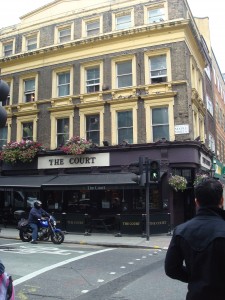
I and many of my peers have tried adhering to Kate Fox’s pub rules, with mixed results. Generally, the more off-the-beaten-path and traditional the pub, the more likely you could buy the owner a drink or observe an invisible queue. You are also far more likely to see actual regulars at one of these pubs than you would at, say, The Court or The Rocket. Regulars cannot easily fit into one category, but you can usually spot them out by their attitude. All of them seem to congregate close to the counter, and are visibly more relaxed than other patrons. Hopefully, we will someday match the relaxed tone of these regulars. Until then, I will continue to observe pub rules and try to figure out where they actually apply.
Tags: 2010 Andrew
September 20th, 2010 · 1 Comment
Back home it never sounded appealing or entertaining to me to see people run around in less than a 30ft area singing and jumping. Much less did I find the price tags of theater plays appealing, with prices generally starting at $100. Therefore, it is safe to assume that beyond school functions I had never seen a professional theater play in America.
That all changed, however, the minute I landed in London. In England people generally value art and the art of performance itself a lot more than in the United States. In the United States for example a performance always has to be entertaining above all this I feel has lowered the quality of shows. In England the people will continually go see a play even if the ending does not leave you with that warm fuzzy feeling and example of which is Billy Elliot.
My experience with plays here in London began with none other than William Shakespeare’s the Merry Wives of Windsor. It was a very good production, but it did not leave me with a feeling of must go see more plays. My second experience was Les Miserables. This show was not a required viewing by my professor but instead I decided to go with a large group of people from my program. I have always heard such good things about Les Miserables I had to just go see it. What a good decision that was. For only £15 or ($22) I not only got one of the best vocal performances I have ever seen, but I was given a political message throughout the storyline. In just 30 ft of limited space a group of 25 people were able to show me all of that. I was sold on the idea of theatre; I finally understand it and am now so willing to go to more. To this point in time Les Miserables is my favorite play.

After this show the group switched gears and went to see a show called 39 Steps; which although it was set in the time period leading up to World War II it turned out to be a comedy. The cast of this show was only a whopping 4 people. Props were limited and the space even smaller than before. These people, however, were able to not only make me laugh but make it seem that they had gone to the country side, on a train, in a manor, and in an apartment. It was amazing, the creativity of such a production. The last show we have seen was The Habit of Art, this show like the one before was also a comedy. The organization of the show was a play within a play, like a behind the scenes movie. The messages from the show and social commentary were surprisingly dead on with what I believe. If there is one thing these shows have taught me is to definitely be willing to go to performances that are little known because sometimes they will be some the best times you’ll have.

The last aspect I noted in all these viewings was the type of audience they all have. Unlike America since the price of shows in London are significantly more accessible the class range of people who attend is astronomically different than back home. I also saw more of the younger generations attend shows here rather than the typical Grandma taking their kids to the show. The only type of people I didn’t notice, which could have been a result of bad observations on my part, was people of non-british backgrounds.
Overall my experience with the theatre in London has been extremely positive and I only look forward to expand my horizons by possibly going to see Operas like La Boheme.
Tags: 2010 Jamie
September 20th, 2010 · 2 Comments

One of the things that make London distinct from almost any other city I have visited is the amount or room dedicated to parks. Walk a few blocks and you are bound to encounter a vast expanse of greenery, or see a small garden area with some benches and statues. While a few of these parks (particularly Greenwich) are more organic in nature, and feel just like large open space areas to roam, most of these parks feel planned out to the last blade of grass. Hyde Park boasts a picturesque lake(The Serpentine) with neatly laid out park benches around it. The grass in St. James’ Park is always perfectly cut, and the main bridge in the middle of the park looks like it was installed yesterday. The shrubbery and gardens in Regent’s Park remind one of Versailles. All of these places seem sculpted to be as visually pleasing as possible.

The trend seems to be that the more central the park to the center of the city (Particularly St. James’ and Regent’s Parks), the more likely the park is to be perfectly planned and sculpted. There are several possible reasons for this. One, it could simply be that the city anticipates more people going through these areas, so they want them to look the nicest. Another possibility is that they expect these areas to get the most tourists, and the parks exist more for image than actual recreation (a point I’ll get to a little later). Finally, it could be that these areas are closest to the monarchy, and they have more of a say over these parks. Whatever the reason, there is no doubt that the parks in London are far more mapped out and planned than a majority of parks in American cities.
The question now is: is such planning a good thing? I personally see it as more of a mixed bag. The parks here are much more visually stunning than most I have seen elsewhere. The feel of the parks harkens back to the original intention of the parks: to make the poor and unprivileged feel like they had access to the wealth of the monarchy. You really feel like you are walking through the Queen’s personal gardens when you take a stroll through Regent’s Park. However, this meticulous planning takes away a little bit of personality from the parks. I get no sense of true, organic, nature while walking through St. James because everything feels so mapped out. In addition, the regal nature of the parks appears to hinder a lot of activity within the parks. Most people seem to simply be walking slowly through these areas, or sitting on a park bench. There are rarely any cyclists, joggers, Frisbee players, kids running around, or anyone playing games. This inactivity is partially because a lot of games are banned in certain areas of the parks, but I think it is also due to the intimidating nature of such perfectly sculpted areas. After walking through the immaculately-trimmed hedges of Regent’s, or after crossing the bridge in St. James’ with the marvelous view of Buckingham Palace, it is hard to think: “Gee, this is the perfect place to run around and throw a Frisbee.” As a result of such overplanning, the parks lose this energy, and also a little bit of quirk.

I love the fact that London has so much green space, and that the city takes such good care of these areas. However, the parks are so meticulously sculpted that the areas seem almost unnatural. The lack of physical activity makes the area feel calm, but it also takes something away from its overall personality. I have enjoyed my time walking through London’s parks, but one wonders whether a bit less planning would make these areas more fun and inviting to the public.
Tags: 2010 Andrew
September 19th, 2010 · No Comments
This is a very long post because I am really, really excited about it. If you don’t feel like reading the entire thing, the part that is relevant to England is just in the section labeled “analysis” at the bottom.
While several other people from our group were off being awesome and seeing the Pope yesterday (I’m still really jealous), there was a scientology protest on Tottenham Court right across the street from the Scientology clinic, complete with V for Vendetta masks, megaphones, picket signs, and a lot of bizarre internet references. This is pretty much a dream for someone like me because it combines angry protestors, really odd subcultures, and a religion that allegedly contains aliens. (I know, right?! Better than Bedlam with psych wards, cannibals, and feminism). So I got a chance to talk to the scientologists inside the clinic for a while, and then I talked to a few of the protestors across the street, one of whom was a rogue scientologist. He termed himself a “squirrel,” which is a person who still believes in the axioms of scientology but has disconnected himself from the establishment.
Anyway, I’m not sure how familiar most people are with scientology. I already knew a lot of the social issues surrounding it because of media coverage, but I’ve never gotten an account of the belief system from an actual scientologist. I’ll give a rundown of the things I thought were important:
Part 1: The woman I spoke to inside the clinic was a little odd, but perfectly happy to talk to me, show me informational films, and give me free literature. She did not attempt to sell me anything, give me a diagnostics test that would tell me I was depressed and should pay her a bunch of money, or otherwise brainwash me. I asked her what she thought about the press coverage of scientology and the allegations that it’s exploitative, and she genuinely didn’t seem to have any knowledge of abuse to people within the church or a pyramid scheme going on. So I’m going to assume she was a believer rather than a person at the head of the church making a ton of money.
According to what she told me, L. Ron Hubbard is the founder of Scientology, but only a man rather than a prophet. He has written all the scriptures (which are read at services on Sundays just like many other religions), the main one being The Thesis of Dianetics. He also wrotes the prayers. I found this interesting because every religion I’ve ever studied has holy scriptures directly from God(s) or a prophet and then some have other important documents written and axioms written by men.
When I asked her about her conversion, she said that she never converted because Scientology is supposed to be addition rather than a superseder of other religions. She was also Catholic and often attended Catholic masses when she was with her parents. This means that scientologists do not officially evangelize. Scientology is also apolitical apparently, no official stances on abortion.
I also asked her about the religion itself. Firstly, no aliens, apparently (disappointing). No mention of Xenu. Thetans, she said, are basically an equivalent to the soul except rather than saying you have a soul/thetan, the soul/thetan is you. There is a trinity of self composed of mind, body, and soul/thetan. The thetan returns after your death, so Scientology is a religion of reincarnation. There are eight dynamics of life which become increasingly broad: self, family and all things sex related, group/friends/community, mankind, living things, physical universe, spiritual self, and infinity/supreme being. This was another detail that struck me as extremely weird because it was the only mention she ever made of God in her whole explanation. There is a whole we-are-all-connected-Lion-King motif with the dynamics, which is very familiar, but the main emphasis she placed on her explanation was self help. Scientology is supposed to allow you to rid the negative energy from your life. It focuses heavily on L. Ron Hubbard’s idea that the mind regulates the body, so believers go to counseling sessions where they work on different aspects of their life (communication, relationships, hostilities of life), and they ascend to different levels as they improve. You are also supposed to study. Scientology offers courses for personal betterment (you have to pay for them because there is no government funding) and you can study to become ordained, in which case you study under a superior and also ascend levels of awareness. A lot of hierarchy going on. They’re especially antidrug because they want to focus on the mind, and drugs are bodily and act as toxins.
If I had to simplify it, I would say she was focusing on psychological self help with spiritual axioms.
Part 2: The protestors outside were equally odd and equally happy to talk to me (They invited me to the pub after about an hour but my stranger danger blinker was buzzing). They are part of an internet based organization called Anonymous, which has taken Guy Fawkes from V for Vendetta as their mascot. They wear the masks so as not to be followed/sued by Scientologists. I could write a whole paper on the internet subculture surrounding this protest, but this post is already way too long. I talked to two of the few people not wearing masks, one of whom was a well researched protestor and the other a Scientologist that broke away from the church. Major issues they had:
- Pyramid scheme – Scientology is organized so that people have to pay massive amounts for counseling to ascend to the next OT (operating thetan, don’t worry, I’ll get to an explanation) level. They can only get free counseling if they agree to volunteer for the church in which case they’re working for insanely low wages, and if they decide to leave the church they must pay for all the counseling they’ve ever had in lump sum.
- The church abuses people by denying them access to medicine they need. Lisa McPherson is an example they mentioned of a woman who died. However, they place people on strong regiments of Scientology vitamins, which make them more money.
- Scientology can label any person as an SP (supressive person) or negative influence on someone within the church. If a superior labels your family member as an SP (this can be for anything, like suggesting that Scientology may be dangerous), you can no longer talk to that person.
While the woman inside said L. Ron Hubbard wrote science fiction to fund his research on the nature of man, the non-Scientologist protestor said the sci fi discredited him. The woman inside said that the church was involved with charitable works for the community and participated in interfaith organizations, but the man outside said that all Scientology’s charitable works were minimal for publicity or self-serving. An example he used was Narconon, a program in which Scientologists provide free counseling and drug rehabilitation, which allows them to pull in more people.

Picture taken from http://www.altogetherdigital.com/20080210/anonymous-vs-scientology-strange-goings-on-in-london/ (Coverage of another Scientology protest in London)
Part 3: This is about the guy who referred to himself as a “squirrel,” a Scientologist against the establishment. He told me a lot more about the way OT levels work because he had risen several levels through counseling before leaving. Thetans are not just personal souls; they’re also energy from different life forces that float around on earth and sometimes attaches to people without either being’s knowledge. Counseling allows you to cleanse yourself of thetans. He actually experienced an exorcism of a thetan as powerful as himself (he said he couldn’t believe that he was controlling his body and she wasn’t) who came back to visit him several days later. He said that he never believed Xenu, an alien in the Scientologist narrative who sent a bunch of thetans to earth’s volcanoes; he understood the story strictly as a metaphor. He did still believe in the axioms, and mention one: “Life is a static capable of postulates and considerations.”
Analysis: I can see why Scientology is so attractive to so many people. It has commonalities with a lot of different religions. The levels of awareness and cleansing are similar to levels of enlightenment in some forms of Hinduism and Buddhism. The 8 dynamics are a familiar hierarchy, and the eighth dynamic infinity/the supreme being. which encompasses everything else, also hearkens back to other religions. For instance, Islam and Judaism focus so much on the infiniteness of God that they are aniconic. You cannot depict God or speak of God without special ritual so that you are not in danger of quantifying God. The trinity of mind, body, and soul seems awefully similar to the Father, Son and Holy Spirit trinity we find in Christianity. Plus, the idea of a thetan, when we compare it to a soul, doesn’t really sound farfetched at all. Yogic Hinduism focuses on releasing negative energy akin to parasitic thetans. Muslims perform ritual purifying before every prayer. The focus on study, the fact that believers are supposed to take courses, is pretty similar to studying the Torah for bar mitvah or the Bible for confirmation.
It’s also very attractive because it reiterates a lot of popular sentiment about psychology and self help. There is already an issue with the overpresecription of drugs because drug companies have so much influence over doctors. Scientology reiterates the fear of overmedication. Western society is also a society obsessed with psychology. More people than ever see therapists. Depression has invaded so thoroughly that it is used a synonym for sadness. A religion that revolves around self help fulfills a need. Also, the fact that Scientology is a spiritual form of self-help with very little emphasis on God might be very practical for the English in particular. The census we saw notes that many English consider themselves spiritual, but do not believe in God.
The attractive part of the religion of Scientology makes the establishment of Scientology extremely terrifying because everything the protestors named had a seemingly reasonable counterpoint. Scientology could be a money making scheme, or it could be that scientology needs money to operate just like any other religious establish needs membership fees and donations to operate. Scientology does not receive government funding in England because it does not pass the means test so maybe it needs even more money (The protestors told me that the Scientology church in England gets around this by registering under Australia which has no means test, but I unfortunately can’t find any research on it). Scientology could be brainwashing people by having superiors hover over them, excommunicating their relatives, and denying them medical attention, or they could just be providing mentors and trying not to overmedicate people. Obviously, there is something wrong with an establishment that abuses people, but from the inside it’s very difficult to define abuse.
We also have to separate the religion from the establishment and look for the good. The “squirrel” I talked to felt deep spiritual benefit from belief in the 8 dynamics, counseling for communication skills, and the release of thetans and energy. None of the stories or axioms he talked about were any siller than a virgin birth, a man whose head is replaced by an elephant’s, or Muhammad splitting the moon. They’re just myths (I mean stories within a tradition, not false accounts) that create a discourse for a belief system. When I asked a man at the Hindu temple why there was a statue of Krishna and not Vishnu, he told me it was because they were the same, and that every god in the temple was a different avenue to the same God, just like there are many different Tube routes back to Tottenham Court (his analogy, not mine). Hokey, yes, but I love this sentiment because it reminds us that tolerance should extend to any path that benefits people. That does not mean we should tolerate an abusive establishment. The protestors told me that unlike America, England defines Scientology as a religion, giving them special legal rights to practice. But it does mean that we shouldn’t dismiss individuals who believe in the Scientology as wackos, especially since the its definition as a religion depends not just on its legitimacy as a belief system but the legitimacy of the establishment that endorses it.
So in summary, we should all respect each other and be friends (Please tell me if you read that entire thing, that my thesis came out to more than that).
A source recommended to me by the protestors:
Sikh comedian’s explanation of Scientology. Recommended by the “squirrel”
Tags: 2010 Jesse
September 19th, 2010 · No Comments
One of the things that has truly surprised me during our time in London and in our readings over the summer was the lack of a widespread religious sentiment and a growing secular way of thinking. Visiting the different places of worship for me has been very enriching. I sincerely enjoyed hearing about the way different roles of various institutions in their communities. Despite this growing secular sentiment, it was evident to me that faith is still an important key to Englishness. Sure, we may not have had the same treatment at the Christian institutions we visited, but we weren’t at the parish church where they would have stressed the other parts of Christianity outside of the famous dead people.
At the mandir, mosque, and synagogue, I did learn something about other faith communities, all of which I wasn’t that familiar with. Familiar with Christian outreach, it was interesting to hear the way other faiths volunteer and conduct outreach. I was also intrigued by the amount of history each guide mentioned; at the mandir, there was a specific exhibit to help you understand the history and beliefs of Hinduism. At the mosque, the guide spent more time on the basic principles, whereas at the synagogue it was much more history heavy, which I enjoyed (despite the slight mix up with who declared the crusades and who ordered Richard’s). Yet, they all stressed the importance of the community and what they did for the community. At the end of each tour, I felt that I had been where a faith was active and thriving- counteracting the general arguments we had encountered.
Before I talk about my favorite experience, I’m going to go off on a bit of rant/tangent. (Nothing unusual, you’re probably thinking.) While Christianity is undeniably not as much on the forefront as it once was (I sometimes forget I’m not in the Middle Ages where the church was as influential as those in political power and grotesques littered the cathedral for unknown reasons), it is still playing an important role in England. How? Most noticeably, the concerts we’ve attended. Sure, they haven’t been lectures in Christianity, but they have brought people into a church where they were witnessing a faith community. You don’t necessarily have to have a lecture about the religion’s history when you are there in order to spark an interest. Sometimes a few trips for concerts or to be a tourist will spark an interest and prompt someone to ask a question that leads to a serious discussion. Yes, it would have been nice to have left any of the churches/cathedrals with a pamphlet on basic Christianity, but because those audiences (presumably) weren’t there to learn about Christianity, a pamphlet may have been more alienating than encouraging.
Okay, so my favorite experience and what it taught me. Hands down, my favorite has been (no surprises) Westminster Abbey. (This may change as I’m hoping to get over to St. Bartholomew the Great tomorrow; it’s a medieval parish church.) Why when it didn’t actually teach me about Christianity or the abbey that I didn’t know? One, because it inspired my faith through the sweeping architecture and stained glass. For me, those are more impressive and awe-inspiring than St. Paul’s (in its present Wren-wrecked – okay, so maybe that’s a bit harsh-state) could ever dare to be. Two, because as a medievalist, I was able to participate in a long-standing tradition: the pilgrimage. Throughout history, people have visited sites throughout the world for many reasons. At Westminster Abbey, everything I love was combined into one place: my faith, grotesques, cosmati, saints, Chaucer, Gothic architecture, etc. I was on a pilgrimage of sorts. True I wasn’t there to pay my respects to Edward per se, but I can’t deny seeing the tomb of such an important figure didn’t give me chills (even though it’s been really messed up and reassembled incorrectly). I didn’t necessarily have to learn anything about Christianity to have an incredible experience. Yet, to say I didn’t learn anything is mistaken. I did, but I learned more about the position of the Church of England. It is clearly in decline, but the abbey is doing what it can given its monumental dual-purpose (protect priceless art and architecture while spreading its Christian message).
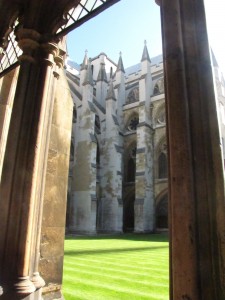
I’m sure some of us would argue that it is up to these major institutions to take the lead in revitalizing Anglicanism, and to some extent Christianity, in England. However, because Westminster Abbey stands for so much more than just Christianity (whether this is a good or bad thing is up for debate), it is important for some of the parish churches to be more vocal on these issues. For Westminster Abbey (and to some extent St. Paul’s) to take a major stand is a conflict of interests, a problem that lays at the heart of its problems rises: should it risk alienating the audience that helps it survive in order to promote its beliefs? It shouldn’t compromise its faith (and I don’t think it does; it does remain closed for services on Sundays as well as hosts small prayers and services throughout the day/week) in order to protect its architecture, nor should it compromise its architecture to protect its faith. They go hand-in-hand in many regards. Without either, you lose part of the abbey. If there was ever a lose-lose, impossible to win situation, double-edged sword, etc, this was it!
I’m hoping as I visit other major medieval cathedrals, a solution to the Christianity vs. tourism problem will become evident, but for now Westminster Abbey will have to be simply (as its Cloister represented for its medieval monks) my paradise on earth.
Tags: 2010 Stephenie · Churches and Cathedrals
September 19th, 2010 · No Comments
So, like many other people, I have noticed the difference in educational programming at the Anglican churches that we’ve visited versus the other religious centers that we’ve seen. At Westminster Abbey I enjoyed the history and all of the famous people buried there (I looked down to discover that I was standing on David Lloyd George’s grave–sorry!), and at St. Paul’s Cathedral I admired Sir Christopher Wren’s gorgeous design and thought of the five hundred stairs that awaited me. So many people have commented on this lately, but I think that Mary Kate is right when she says that we have a valuable opportunity to look at and discuss Christianity in Britain in terms of Pope Benedict XVI’s visit.
In the course of my research for our walking tour, I stumbled across an interesting opinion on the de-Christianization of the British, and it had nothing to do with immigration or the emergence of other religions. In the introduction to his book A Revolution in the Head, Ian MacDonald comments that the baby boomers were the last generation to attend church regularly, but that Christianity had been on the decline for much longer than that. MacDonald argued that science was to blame–as more and more scientific developments were made, especially in terms of medical discoveries and Charles Darwin’s theory of evolution, it became more and more difficult for people to balance this new information with Christian beliefs, and scientific ideas began to take precedence.
The more I thought about this, the more it made sense to me. As the imperial capital of the world for so many years, England was the place where so many new ideas and discoveries originated. This country, and especially London, has hosted radicals and revolutionaries in terms of politics, art, and science. If scientific ideas were going to take hold anywhere, it makes sense for it to be here. Based on what I’ve learned of the 1960s, I can also understand why the baby boomers really started moving away from religion. The Anglican Church was traditional and belonged to their parents’ generation, and the sixties were about youth making their own mark and breaking away from tradition. Religion may very well have been a partial victim of the sixties.
I’m not saying that Christianity is still a tired religion–in my experience, there has been a definite move to adapt the religion to changing times and to attract more followers. But it seems that this isn’t going so well in Europe, and one of the reasons may be the perceived gap between religious leaders and the public. To me, the fact that Cardinal Kasper called England a “Third World country” immediately before the Pope’s arrival shows amazing insensitivity to the cosmopolitan make-up of Britain’s population and ignorance as to how to reach out to people. He certainly did not do the Pope any favors in this already contested visit.
This seems to speak to what our guide at the East London Mosque was saying about the need for different religious groups to understand each other. In this case, Christian leaders perhaps need to learn how to better relate to a widely secular public, especially by not distancing them with offensive remarks. In terms of wider, inter-religious understanding, I admired our guide’s willingness to admit that education is necessary on the part of both Muslims and non-Muslims. But I was puzzled that he seemed to resist the opportunity to engage us on that level. I felt that he stereotyped us as ignorant Americans, and that we missed the opportunity for a good dialogue on some very important issues.
The religions that we’ve engaged with during the past month are all tolerant religions, but it seems to be that people need to follow their own teachings a bit better, both in terms of learning about other religions and in terms of relating to people who supposedly belong to the Church of England.
Tags: 2010 Holly · Churches and Cathedrals
September 19th, 2010 · 1 Comment
I’ll admit that I have not been to a wide variety of pubs, so I’ll have to do my best to draw conclusions from the experience I do have. I have genuinely enjoyed the ones I have been to, we’ve just been so darn busy here and I’m always so tired that I don’t go out very often. I disagree with some of my classmates who have been arguing that pubs are overpriced and that the food isn’t worth it. I actually think some of the pubs have pretty good deals. At some you can get a sandwich and chips or a sandwich and a drink for under four pounds, which is more than you can say for Pret or Sainsbury’s, depending on what you get there. The food might not be the best, and certainly not the healthiest, but on occasion I enjoy a bit of grease, and I especially like the part where you order and they bring you the food and you don’t have to do anything. Also there are chips (fries) which are my favorite food in the world.
I’ll start by comparing pubs at lunch and pubs at dinner. I’ve found that it’s a lot easier to get into pubs at lunchtime; it’s a lot less crowded. When it isn’t crowded, I feel sure that I’m not intruding or bothering anyone. Walking into a crowded pub at dinnertime or at night can be awkward because you’re unsure if all the people there already know each other or if you’ll be taking someone’s regular table or chair. It can be a bit unwelcoming.
The exception to this that I’ve found is the Court. The Court seems to cater specifically to a young, student crowd with their meal deals and discount card. Everyone seems to go there with their own group of friends and doesn’t really pay anyone else any mind. I don’t get the impression that there are “regulars” there. Students can be a bit transient. The consequences of this younger crowd, however, are extra loud American pop music, questionable wardrobes, and general drunken disorderliness. The times I’ve gone there I’ve had a good time, despite the fact that I have to shout to be heard and worry that I’m going to get beer spilled on me at any moment.
I agree with George Orwell that pubs where it is quiet and you can hear yourself talk are preferable. The Marlborough Arms has this advantage over the Court. The music is softer and there is less drunkenness. I feel generally welcome there too, although the crowd is a bit older and I do get the feeling that there are regulars, most of whom are British. I think the regular thing contributes to the different level of classiness, though. However, I also agree with Orwell that you can’t win on all counts – the food at the Marlborough Arms is more expensive.
I think as a group we are beginning to get the hang of the buying drinks in rounds thing, and some people remember to ask to buy the bartender a drink, although they usually refuse. Still, I’m not sure that we will ever fully be able to pass for being English in a pub, and I think that although we have knowledge of the general pub rules, each individual pub has its own hidden rules and traditions. I’m hoping that perhaps this will get easier when we go out with our roommates at UEA who are actually British.
Tags: 2010 Kaitlin
September 19th, 2010 · 3 Comments

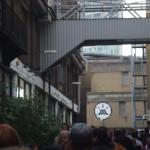
British street art is British for many reasons. First of all, it is rather egalitarian. Anyone can go up to a wall, etc. and post something. Street art also provides a sense of camaraderie and bonding the Brits so desperately desire, demonstrated in the mass art movements (in this post, the space invaders (p.s. there’s one right outside of Arran!) and einsteins-on-bikes). Though one may say that street art is generally anonymous and therefore no one gets a real sense of friendship – well, that demonstrates their social dis-ease. A sense of camaraderie without social interaction? British social utopia. These mass movements also embody the idea of fair-play, as anyone with a couple tiles (for space invaders) and anyone who can call Fatheads (large adhesive poster company, for Einstein) can contribute to these city-wide projects.
Other ways in which British street art demonstrates the conclusion section of Kate Fox’s book (and the main indicators of British social interaction and sociological thinking) are the ideas of moderation, modesty, and courtesy:
Moderation – Yes, street art in the simplest sense violates moderation. However, compared to American street art, it is very much so. A lot of American street art is gang signs, or is much more graphic (in general) than say… little weird monsters, pacman characters, or a large prelican-y looking thing. Even the famous banksy highly disguises political messages by reducing potentially graphic scenes into less explicit ones (but, at the same time, makes them all the more powerful!): http://blog.collectables-now.com/2008/01/12/bank-on-banksy/
Modesty – most British street art remains anonymous. Though there are exceptions to every rule, much of the art is left unsigned. No one still knows who Banksy, arguably the most famous street artist of all time, actually is. Looking above – clearly the squirrel and bird/pelican are of the same artist, and require a bit of skill. Neither has a signature.
Courtesy – my favorite, and in my opinion the most distinctive, aspect of British street art. A large amount of British street art is on non-permanent structures, like construction panels (see above pictures), or is either sprayed on newspapers which are then posted on walls, or are somehow non-permanent (like the einsteins, or the old woman).
Well, British street art is two things: awesome, and really British. Let me know if you find any that you think is neat, and let me hear your thoughts on whether you think it is British.
Tags: 2010 ChristopherB



















